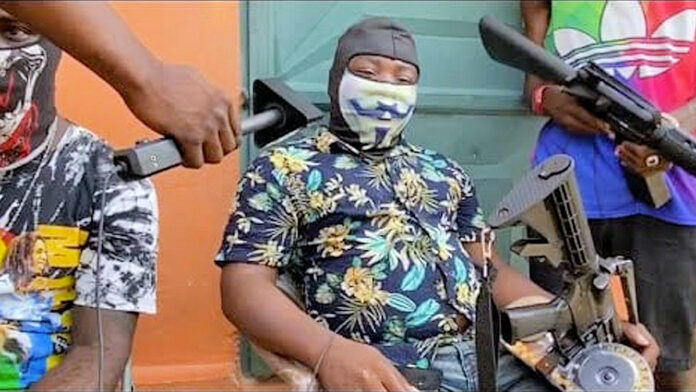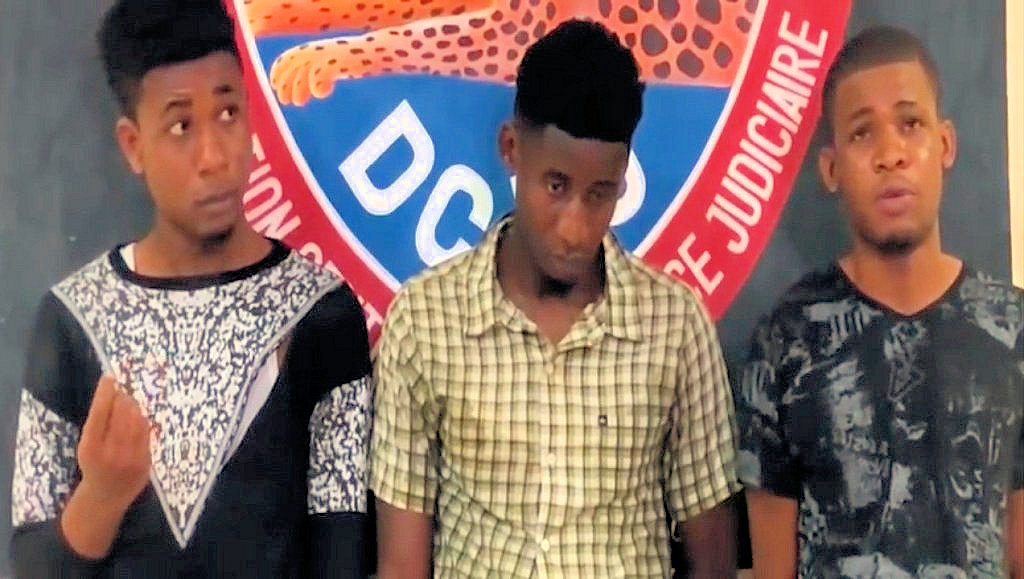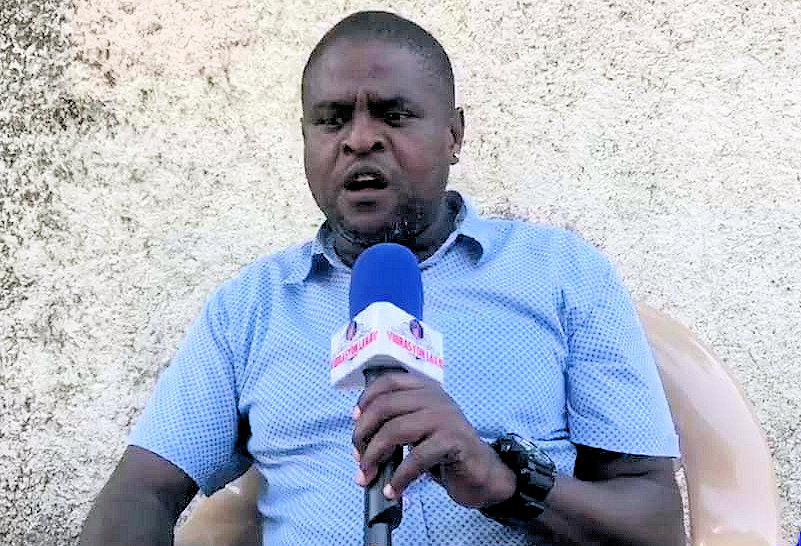
(Français)
It was the kind of foolish police operation born of hubris and too many Hollywood movies.
On Mar. 12, 2021, a dozen heavily armed policemen from the most elite tactical unit of the Haitian National Police (PNH) – the Special Weapons and Tactics (SWAT) team – drove into Village de Dieu, one of Port-au-Prince’s most wretched shantytowns, in two armored vehicles.
The slum is home to one of Haiti’s most notorious gangs, the Five Seconds Base, led by “Izo,” in his early 20s, reputed to be the #1 gang leader and kidnapper in Haiti. Three days earlier, his gang members strafed with automatic weapons the headquarters of Electricité d’Haïti (EDH) on Harry Truman Boulevard in the nearby Bicentennaire district, killing a motorcyclist and wounding an EDH employee.
As the SWAT team in their armored vehicles crept into the shantytown, unsure of the rarely police-penetrated area, residents pointed and called out, apparently directing them to the gang’s headquarters. Instead, they led the vehicles into a giant hole, where they were ambushed with a hail of gunfire. Four of the policemen were killed, three of their bloody corpses dragged through the streets. Another eight SWAT team members were wounded, two of them gravely. The Five Seconds Base captured both armored vehicles, burning one of them. They also made off with the SWAT team’s automatic weapons, body armor, radios, and other equipment.

“The [Haitian National] Police wants to kill us,” cried one desperate policeman in a piteous phone call as the raid unraveled. “We’ve been calling the police for back-up for two hours, but they’ve never sent it… Right now, it’s every man for himself… They’re trying to burn six of our guys in one of the vehicles… I will never remain on this police force. They’ve got five of us surrounded. We can’t leave where we are. We don’t know what to do. My phone is about to discharge… The bandits are massing to kill us. I have a wife and children. If they don’t send back-up soon, I’m going to shoot myself because I don’t want the bandits to finish with me their way.”
The shocking accounts, footage, and images of the raid-gone-wrong went viral on Haitian social media, stunning Haitians worldwide.
Disappearing State Authority
This wrenching episode is not the result of racist and imperialist rationales that Haitians are savage, explosive, uncivilized, and innately unable to govern themselves, as openly expressed in books by several U.S. Marine veterans of Haiti’s 1915-1934 military occupation, like Capt. John Houston Craige, who penned “Black Baghdad” (1933) and “Cannibal Cousins” (1934).
Rather it is the inevitable culmination of two centuries of embargos, sabotage, bullying, aggression, destabilization campaigns, coups d’état, military occupations, and theft of territory and treasure against a nation founded through history’s only successful slave revolution, capped off by U.S. State Department policy over the past four decades, which has systematically done an end-run around the Haitian state, more often working directly with NGOs.
there is division over how to manage the growing lawlessness and anarchy
On Feb. 7, 2006, President René Préval announced at his second presidential inauguration that his primary goal would be to “reestablish the authority of the State,” which had been undermined by two U.S.-fomented coups d’état and subsequent foreign military occupations over the previous 15 years. But now, 15 years and two “electoral coups d’état” later, Haiti’s state authority is weaker than ever.
“Never in our country’s history have we been so close to what one might metaphorically call suicide,” said Haïti Liberté’s Mar. 10 editorial prophetically entitled “On the Brink of Chaos,” two days before the disastrous police raid. “The country is well and truly divided, and the divide between the rich and the poor keeps widening.”
Divisions in the Ruling Class
This growing chasm is also creating a divide in Haiti’s ruling class. One sector of Haiti’s comprador bourgeoisie – including businessmen like Dimitri Vorbe and Réginald Boulos – are backing a growing popular uprising against the emerging dictatorship of de facto President Jovenel Moïse, who has ruled Haiti by decree since Parliament’s expiration on Jan. 13, 2020 and whose own Constitutional term limit came on Feb. 7, 2021. Another faction – including National Endowment for Democracy (NED)-spawned pro-coup “Group of 184″ coalition leaders and assembly industry magnates Andy Apaid and Charles Henry Baker – are backing Moïse, and allegedly getting land and millions of gourdes in return.
But even within the embattled, shrinking Jovenel Moïse circle, there is division over how to manage the growing lawlessness and anarchy which is sweeping Haiti as bourgeois families retreat to their mountain fortresses, leaving neighborhood strongmen to emerge in the shantytowns of Haiti’s growing lumpen-proletariat.

Due to the vicious death spiral of Haiti’s economy caused by the empire’s coups and occupations, there are few jobs to be had, other than government sinecures. As of 2019, the official unemployment rate was 13.78%, greater than Yemen (12.91%), South Sudan (12.24%), Somalia (11.35%), or Afghanistan (11.12%). Many of the 86% statistically employed subsist in the informal sector, hawking bottles of sugar-water or plastic sunglasses on the exhaust-choked streets, or finding odd-jobs digging sand, hauling wood, or fixing broken automobiles and radios. Even those with salaried jobs in the sweatshop parks cannot survive on the $6.41 per day minimum wage and must rely for survival on about $2 billion of remittances annually from family overseas.
The result has been that the “gangs,” which began to proliferate after the Duvalier dictatorship’s 1986 fall as “vigilance brigades” to defend against the marauding forays of the former “Tonton Macoutes” (as Duvalier’s paramilitary force was called), have gradually been transformed from defensive to offensive activities to take care of their neighborhoods.
Originally, they were paid by the bourgeoisie to protect its property: stores, warehouses, garages, and vacant land, always encroached on by homeless squatters. Increasingly, the lumpen gangs were called upon to settle scores: burn a rival’s gas station, or even carry out a murder.
Following a U.S. SEAL team’s removal from power at gunpoint of President Jean-Bertrand Aristide on Feb. 29, 2004, “modern kidnapping” (as Aristide characterized his abduction) was now on the table and has mestastacized across Haiti over the past 17 years. The kidnapping business was originally mostly controlled by the bourgeoisie, which hired gangs to carry out abductions then guard and harbor the hostages. This long-suspected secret was revealed on Oct. 22, 2012 when Haitian police arrested prominent bourgeois family scion Clifford Brandt, whose band of kidnappers had abducted Nicolas (24) and Coralie (23) Moscoso, who were from a family largely owning Sogebank.
Kidnapping has now become so pervasive that not only gangs in Haiti’s poor neighborhoods turn to it as one might have once taken up cleaning the windshields of cars idling in traffic. The case of high-school student Evelyne Sincère last October brought this depressingly home. Obed “Kiki” Joseph, 24, kidnapped Evelyne, 22, his own girlfriend, with the help of two friends, thinking that her father had money. Trying to impress Obed (who pretended to be a medical student), Evelyne had told him that her father was a deacon and small business owner. In fact, he was a very poor man who pushed and pulled carts for a living. The trio ended up killing Evelyne and dumping her body on a trash heap in the street. All the details came out in their emotional confession and the police review of their Facebook communications.

Much of Haiti’s kidnapping, it appears, is run by the gangs operating out of Village de Dieu and nearby Grand Ravine, two blighted neighborhoods in the capital’s southern end straddling the choke-point intersection known as Portail Léogâne.
The gangs ask exorbitant ransoms, usually $1 million or $2 million, settling sometimes for tens of thousands. The revenues from the business has allowed them to invest in vehicles, weapons, and radios that make their abductions much more professional than crude copycats like Obed Joseph’s crew.
The kidnapping racket’s most important expense is buying off the neighborhood’s population. When slum residents face a financial problem, which is often – for a funeral, a wedding, a car accident, medicine, or school books and uniforms – they ask the local gang for money. They have nowhere else to turn. This is why the Village de Dieu residents helped lead the unfortunate SWAT team into a trap; it was in their interest to do so, as they see it.
Divisions in the Government
Faced with the kidnapping epidemic which has touched and outraged more and more of Haitian society, Jovenel Moïse’s government has seen a public rift emerge in its own ranks.
Prime Minister Joseph Jouthe leads one faction, which proposes that the Haitian government should outlaw black-tinted windows on vehicles and increase police road-block check-points where abductees might be rescued. It is a defensive approach.
The kidnapping racket’s most important expense is buying off the neighborhood’s population.
However, Renald Lubérice, the Secretary General of the Council of Ministers and the right-hand man of Jovenel Moïse and Justice Minister Rockefeller Vincent, champions an offensive, agressive policy against the gangs, where the police would enter armed slums in an attempt to confront, arrest, or at least disrupt gang members involved in kidnapping. The Mar. 12 tragedy was this tactic’s result.
Lubérice’s approach is delusional. He thinks that the problem can be solved by fire-power. In reality, waging a war on the gangs at this moment is tantamount to waging a war on the shantytown residents that surround them, support them, and regularly benefit from their ill-gotten gains. Other than an occasional show project, the government provides no other alternative for the masses’ survival in terms of social programs, housing development, infrastructure improvement, food subsidies, or employment opportunities. The Jovenel Moïse government has demonstrated neither interest in carrying out progressive social reforms nor the capacity, even if it did, given its growing pariah status both nationally and internationally, save for Washington and its allies which value its ornamental role in the campaign against Venezuela, in particular.
The Haitian bourgeois opposition to Jovenel, as represented by its two principal intertwined fronts, the Political Direction of the Democratic Opposition (DIRPOD) and Democratic and Popular Sector, has muddled matters by accusing the government of supporting the kidnapping gangs. The charge is patently illogical, implying that the regime is destabilizing itself.
Ironically, many nominally leftist critics, who are following DIRPOD’s lead, echo the same cry, arguing that the regime is using the kidnappers to terrorize Haitians, scaring them from turning out to anti-government demonstrations.
The Anti-kidnapping “Gangs”
Even more confusing is that both the bourgeois opposition and its leftist followers conflate the kidnapping gangs with those organized to stop kidnapping in their neighborhoods and beyond, sort of armed “vigilance brigades” on steroids.
The most visible spokesman of this sector is Jimmy “Barbecue” Cherizier, an ex-cop who guards the Delmas 6 neighborhood where he grew up. He got his nickname because the neighborhood had three boys named Jimmy, so, because his mother sold barbecued meat, he became known as “Jimmy Barbecue.” Until just over two years ago, Cherizier was a gung-ho officer in the Departmental Unit for the Maintenance of Order (UDMO), which is deployed precisely to stamp out gang activity, dismantle road barricades, and deal with popular unrest.
Cherizier was part of about 200 Haitian police officers who, under the supervision of the United Nations Mission for Justice Support in Hait (MINUJUSTH) police force, raided the Grand Ravine neighborhood in the early morning hours of Nov. 13, 2017 to root out gang activity, including kidnapping.
As he tells it, Cherizier’s UDMO unit was deployed with several other police units in the early morning hours. After making arrests in Grand Ravine, his unit was called to provide backup to another UDMO unit at the Maranatha College campus. Tipped off by the school’s director, he and other officers went to retrieve two automatic long guns hidden by the local gang in a school depot. Unknown to the policemen, gang members were also inside the depot and opened fire when one of the cops went to unlock a door inside the depot. Two UDMO policemen were shot dead. Cherizier attempted to shoot into the room but had to retreat. The gang members who had been hiding in the room escaped. As other police units engaged the fleeing gang members and others, fighting engulfed the Maranatha College campus, where there was gunfire, teargas, and confusion.

There were conflicting reports, as usual, from the UN, Haitian police, and civilians. Whatever happened that day (Jake Johnston published a comprehensive report in The Intercept), the two policemen were killed along with at least nine civilians. Although one report claims there were signs of summary executions, Cherizier contends there were none.
According to Cherizier, the Haitian high command, after congratulating him, was terrified by human rights groups’ condemnation of the bloody confrontation. They denied responsibility for the raid, saying it was a rogue operation. When they summoned him for disciplinary review, he was sure that they would make him the fall-guy. He refused to respond to his summons.
Then, a year later on Nov. 13-17, 2018, there was another massacre in the slum of La Saline, a swath of concentrated poverty just west of Avenue Jean-Jacques Dessalines, the capital’s main thoroughfare. Haitian police accused Cherizier of being one of “the presumed authors” of the horrific attack, which reportedly involved rape and arson and left an unclear number of people (including children, witnesses say) dead. Human right groups put the death toll between 15 and 71.
Cherizier vehemently and categorically denies having any advance knowledge of or connection to the La Saline attack. Nonetheless, a 2019 U.S. State Department report says that “[a]ccording to MINUJUSTH, witnesses reported three police officers were seen with the gangs during the attack. Two of the officers, Gregory Antoine and Jimmy Cherizier, were dismissed from the [PNH] in December 2018.”
A Feb. 17, 2020 report by MINUJUSTH’s successor, the United Nations Integrated Bureau in Haiti (BINUH), reviewed another series of gang confrontations from Nov. 4-6, 2019 in Belair, a neighborhood not far from Delmas 6. “During three days, several attacks against the residents of Belair led by gang members resulted in three dead, including a gang leader, and six wounded,” the report said. “Around 30 houses and 11 cars were burned.”
The BINUH report refers to Belair as a “pro-opposition zone” in which Cherizier’s gang “was clearing roadblocks.” Such formulations imply that Cherizier’s gang was attacking Belair because of its anti-government leanings.
Cherizier says he was not personally involved in the November 2019 Belair attack but does not deny that Delmas 6 men fought against those in Belair. He claims it was in retaliation for an earlier attack from Belair on their neighborhood.
While proof, truth, and clarity remain elusive, Cherizier has become the foremost bogeyman in Haiti of both Washington and the United Nations, and in February 2019, the PNH issued a warrant for his arrest. Over two years later, he still remains free.
[The account of the 2017 Grand Ravine confrontation between police and gangs has been updated. Widespread reports of government cash and land grants to Andy Apaid, a Jovenel Moïse supporter, have since proved to be false.]










[…] he is particularly hated by the police for his gang having killed four police officers in a failed March 2021 anti-gang operation. Police have concentrated their efforts on dislodging him, and rumors that Izo was shot and wounded […]
Black men should unite…